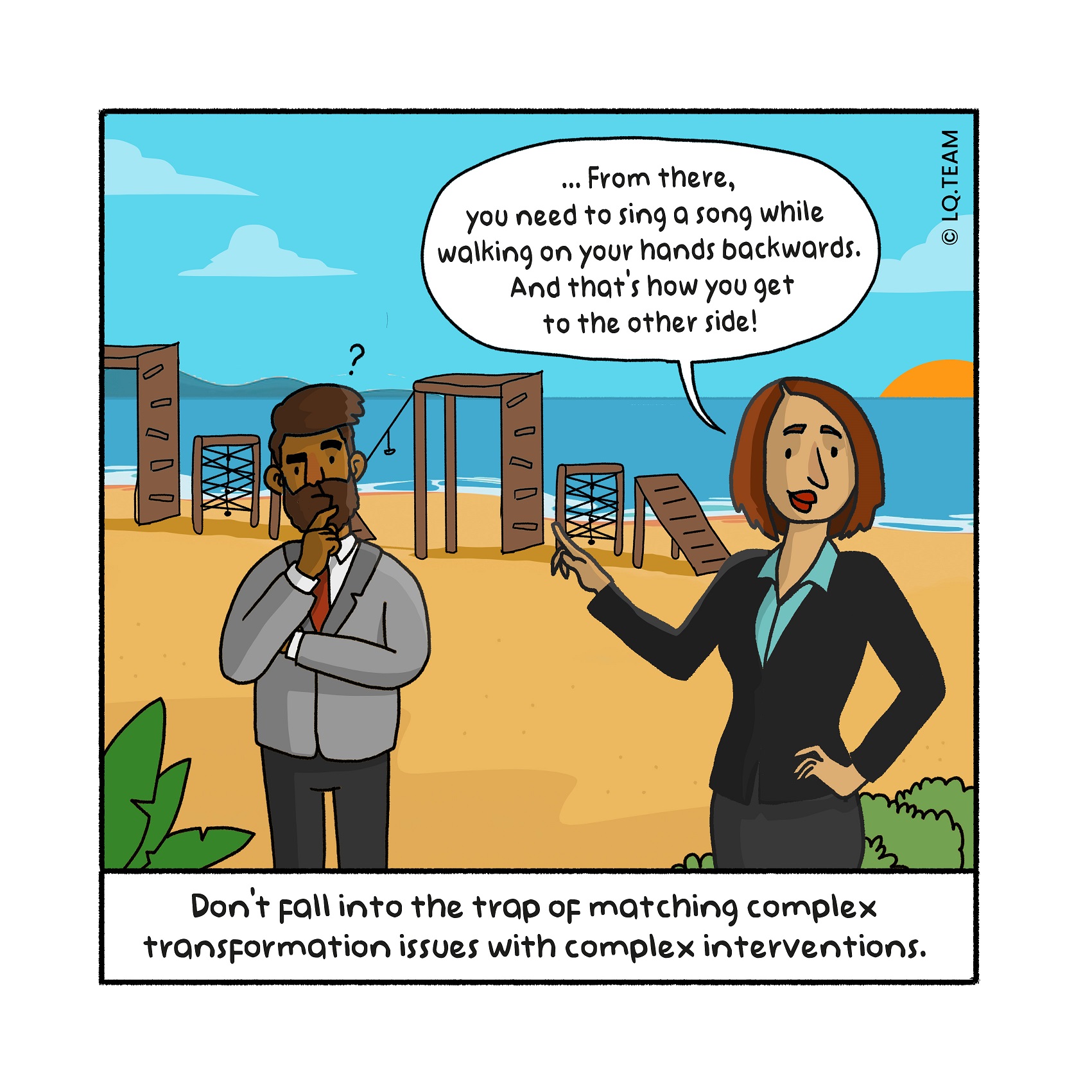
Nut to crack: How to design a practical transformation roadmap
Every transformation journey is different. You may get clarity on your goal, but not know how to get there. What subjects do you tackle, and in which order? And how do you structure your plan?
Nutcracker: Determine the adjustment required on the five organisational development dials
Go back to your case for change and the corresponding change story (see Challenges 1 and 2). Consolidate the essence into a few core design princi- ples. These principles are then the leading design principles for all organisa- tional design dials, so in terms of behaviour, processes, organisational struc- ture and kpis.
Suppose your case for change concerns putting the customer first in every- thing you do. In that case, the essence of the organisational change could for example be brought back to three topics:
- Customer data is leading
- Anything to get a smile from the customer
- Requested today, delivered today
If customer data is leading, leaders must make decisions based on this data instead of their gut feeling. It requires adjustments in the organisational struc- ture so that customer data analysis gets organised and resourced. It requires processes and systems to support customer data collection, processing and reporting. And it requires people capable of interpreting that data and con- verting it into targeted actions.
Five dials of organisational development
As mentioned in Challenge 9, there are five dials you can tune to realise a successful change in daily operations:
- Strategy and conversion to portfolio and individual goals
- Organisational structure and responsibilities
- Processes and systems
- Convictions and behaviour, starting at the top
- People’s capabilities
I call these the five organisational development dials.9 The “Convictions and behaviour” dial is an interesting one because you can influence it directly, as well as influence it by tuning the other four dials. Suppose you want to en- courage cost-saving related behaviour. In that case, you can manage this by conversing with employees about how they can reduce costs in their work. Simultaneously, you can redesign processes to eliminate waste or focus more on cost savings by adjusting business leaders’ related key performance indi- cators. In turn, this will influence the behaviour of the individuals working in these processes or impacted by these kpis.
Using the design principles, you can determine the difference between the current and the desired design for each of these dials and map the interven- tions needed to achieve the organisational transformation. You can assemble the most important ingredients for the transformation roadmap by systemati- sing this, supported by the correct data. The real-life example illustrates the above, and the support tool contains a framework you can use to design your roadmap. In the Appendix, you can find a template for a transformation plan. It shows you how to collate the information from the different nuts into a robust plan.
Support tool: Define the ingredients of your transformation plan The framework helps you to design an integrative change roadmap. Define the status of each of the organisation’s development dials. Clarify desired end goals on each dial as well. Then explore which interventions you may need per design dial. Check back against your design principles to see if the interventions proposed will help achieve the core change ambition.
Example
I want to bring this support tool to life with a short example. Suppose you are the director of a consultancy firm. Until now, your consultants have solely been responsible for solutions delivery to clients. To grow, you want to see them take responsibility for business development activities. To realise this organisational change, you design several steps, with a timeline for imple- mentation.
First, you share the growth ambition of the organisation with the consultants and the consequences this has for the development of the consultant role and the responsibilities that come with it. This generates a move on the strategy dial including a translation to individual objectives. You then design a two-day strategic sales training course to practice all the steps in the business devel- opment process, from creating demand to evaluating and renewing contracts. All consultants take this training course in the following two months. During that period, you also take on two new consultants who are experienced in key account management and have proven sales track records. That’s how you work on developing your people’s capabilities.
After the training, you give the consultants access to the quotation and con- tract system so that they can submit proposals to customers, and you train them in using this system. This is how you advance on the process dial. You coach your consultants weekly for three months on how to activate their net- work and conduct business development conversations effectively. During the journey, you celebrate every sale a consultant makes. Here you let them tell their colleagues about how they achieved success. This influences the convictions and behaviours dial.
Finally, you introduce a system called sales credits to recognise the consul- tants’ efforts in realising project sales. This systems’ dial intervention helps to reinforce the desired behaviour. After a period of nine months, most of the consultants are developing business development activities, and sales successes are becoming visible.
Real-life example: Reconquering the market
A big player in the beverages sector has been the European market leader for ten years now. However, it is being overtaken left, right and centre by other players, large and small. Customers are choosing other brands for their superior pricequality ratio, su permarket chains complain about the lack of innovation power in the company and employees are frustrated about the internal complexity and lack of speed. Marius, the ceo, who has been at the helm for five years, is facing a considerable challenge. How does he navigate this tanker into smoother waters?
He starts by reorganising his top team. He lets two executives go and hires three new ones. He works on the case for change and the corresponding change story with this newly formed executive team. This change story is so clearcut that it provides enough support to steer each manager and employee through their transformation process. But Marius does not stop there. With his top team, he translates the change story into how they can each be a role model for the behaviour of the change they want to see. Essen tially, he tells them, it comes down to this: if we examine every step we take through the lens of impacting our planet, listening to our customers, and focusing on operational excellence, we will be able to reconquer the market. Three principles – planet positive, customer first, zero waste – shape the transformation plan’s design. Consistent with the zero waste principle, internal financial, purchasing and hr procedures are simplified or discarded. Customerfirst comes to life by sending leaders out onto the streets to talk to consumers and listen to their feedback firsthand. Next, these leaders ensure consumer feedback is anchored in all marketing and sales processes. Five incubator teams are installed that accelerate the innovation execution through design sprints. Planet positive gets anchored in the core of the business strategy; investments in sustainable solutions are prioritised over nonsustainable products. The supply chain is rigorously redesigned into a circular process. And all of this is supported by a communications campaign touch ing every employee.
The benefits of this transformation programme are to be reaped only 18 months later, while early signs of success are visible; retailer reviews are improving, consumer trust is growing, and employee feedback proves internal complexity has reduced.
The transformation is not yet concluded, as the business results are not where they need to be yet, but the green shoots of recovery are showing.
Tip for change leader
Don’t fall into the trap of matching complex transformation issues with complex inter ventions. The critical question is: what is the most direct intervention to enable a giant leap forward? See Challenge 34 for more inspiration.
Tip for change enabler
Declaring a cost reduction initiative in a fancy hotel, where everyone is listening to the speech on why cost reductions are necessary from luxurious seats, sends a conflicting message. You may feel the example is exaggerated, and that would be a credit to you. Unfortunately, it is a reallife example, and not an isolated case. In many transformation journeys, one thing is being said whilst something else is being done. As the text men tions, the design principles can be leveraged to determine the “how” of the transfor mation activities. If, for example, environmental sustainability is one of your principles, organise your next meeting at a circular hub of a company which disrupts your industry from a sustainability angle. See Challenge 39 if you want to check how consistent you are in the nonverbal messages you send out versus the verbal ones.
Kernel: Simple but holistic design
The design principles of the transformation journey and the organisational development dials help you determine which transformation actions are to be put on your roadmap. To test if that roadmap will do the job, check the change readiness of the receiving entity. See Challenge 15 for more information.

